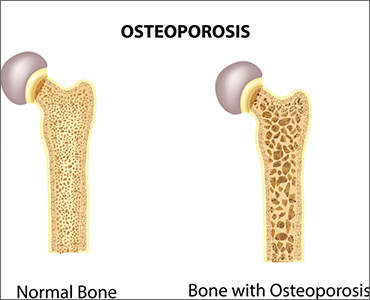
This article was published on: 03/6/19 5:43 AM
Osteoporosis causes bones to become weak and brittle, so brittle that a fall or even mild stresses like bending over or coughing can cause a fracture. Osteoporosis-related fractures most commonly occur in the hip, wrist or spine.
Bone is living tissue that is constantly being broken down and replaced. Osteoporosis occurs when the creation of new bone doesn’t keep up with the removal of old bone. Osteoporosis affects men and women especially older women who are past menopause are at highest risk. Medications, healthy diet and weight-bearing exercise can help prevent bone loss or strengthen already weak bones.
Once bones have been weakened by osteoporosis, you may have signs and symptoms that include back pain, caused by a fractured or collapsed vertebra, loss of height over time, a stooped posture etc.
How likely you are to develop osteoporosis depends partly on how much bone mass you attained in your youth. The higher your peak bone mass, the more bone you have “in the bank” and the less likely you are to develop osteoporosis as you age.
Some risk factors for osteoporosis are out of your control, including your sex, age, family history, body frame size, calcium intake, eating disorders, alcohol and tobacco consumption.
Medically, it is established that women are much more likely to develop osteoporosis than are men. As you get older you are at greater risk of osteoporosis. Having a parent or sibling with osteoporosis puts you at greater risk, especially if your mother or father experienced a hip fracture. Men and women who have small body frames tend to have a higher risk because they may have less bone mass to draw from as they age.
Osteoporosis is more likely to occur in people who have low calcium intake. A lifelong lack of calcium plays a major role in the development of osteoporosis. Low calcium intake contributes to diminished bone density, early bone loss and an increased risk of fractures. Besides, various eating disorders also lead to Osteoporosis.
People who have anorexia are at higher risk of osteoporosis. Low food intake can reduce the number of calories and amount of protein and calcium ingested. In women, anorexia can stop menstruation, leading to weaker bones. In men, anorexia lowers the amount of sex hormones in the body and can weaken bone.
The lifestyle of an individual significantly determines this condition. Some bad habits can increase your risk of osteoporosis such as excessive alcohol consumption and tobacco use. Regular consumption of more than two alcoholic drinks a day increases your risk of osteoporosis. The exact role tobacco plays in osteoporosis isn’t clearly understood, but it has been shown that tobacco use contributes to weak bones.
Bone fractures, particularly in the spine or hip, are the most serious complication of osteoporosis. Hip fractures often result from a fall and can result in disability and even death from postoperative complications, especially in older adults.
Prevention is always better than cure. There are these three factors essential for keeping your bones healthy throughout your life i.e. taking adequate amounts of calcium, intake of sufficient vitamin D and a regular exercise.